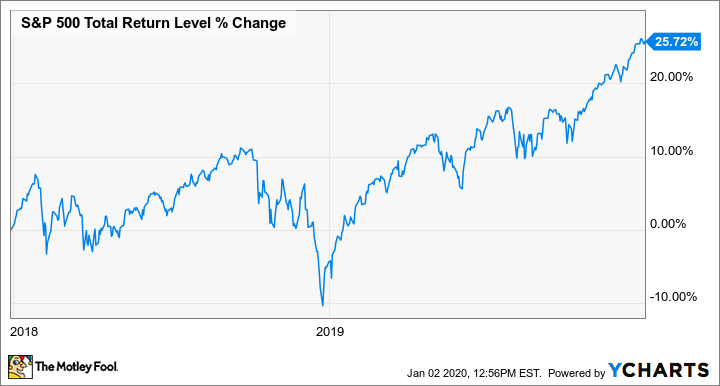Congratulations! Setting aside five Benjamins for your future is no easy task. Whether you want to invest for retirement, future college expenses, or financial independence, you've taken the first important step.
So you're thinking, "OK, now what?" Luckily, it's never been easier to put your money to work. We'll look at a few investments that are great for getting started. But first, here's some perspective on what happens with your money when you invest in the stock market.
What to expect
To understand market returns, the S&P 500, an index made up of 500 of the largest U.S. based stocks, is a great proxy. It has returned about 10% annually on average over long periods of time, but each year's returns vary considerably. The graph below shows its annual returns for the last 31 years before dividends. You'll notice that not every year is in the positive range, and some gains are in the low single digits. The worst year was 2008, with a 38.5%, decline, and the best year was 1995, with a 34.1% gain.

Returns don't include dividends. Data from Wikipedia. Chart by author.
The next graph looks at the S&P's last two years more closely. You'll notice 2018 was a roller coaster ride for investors, hitting a 10% gain, then dropping into the negative range to end the year. But over the two years, the S&P 500 has achieved an impressive 25.7% return.
Buying into the market or individual stocks means that you will see ups and downs on a daily basis. Long-term investing requires the patience to ignore this short-term volatility and hold your investment for years or even decades. Because of short-term uncertainty, it's important that you keep money that you need for the next three to five years out of the market. Having an emergency fund is also a good idea to protect you from dipping into your investments at a bad time.
Assuming you have all of that covered, let's see how to put that hard-earned money to work.

Image source: Getty Images.
Getting in on the market
If you don't have any exposure to stocks in your 401(k) or other investments, a good place to start would be a low-cost stock index fund. The Vanguard S&P 500 ETF (VOO -0.40%), which tracks the performance of the S&P 500, is a great choice for new investors. Index funds or ETFs (exchange-traded funds) give you exposure to a broad array of stocks in one simple investment. There's no worrying about whether your investments will lose to the market; with the Vanguard ETF, you will earn returns equivalent to the S&P 500 except for the low annual fee of 0.03%.
Another advantage of this kind of investment is that you can invest in fractional shares. Since this ETF is trading around $297 today, you'd be able to buy 1.68 shares, fully investing your $500.
If you already have exposure to stocks through your employer's 401(k), investing in individual companies might just be right for you.
Buy what you know
Investing in individual stocks might seem like a scary adventure, but it doesn't have to be. Peter Lynch, one of the greatest investors of our time, was able to beat the market by buying companies that he knew and was comfortable with. If you are a coffee lover, it's likely that Starbucks (SBUX 0.74%) is a company you probably know well. Do you shop online? Then what about Amazon.com (AMZN -0.86%)? Do you own a house? Maybe you've made many trips to Home Depot (HD -0.11%) for a recent weekend renovation project. All three have been tremendous winners over the past 10 years and offer plenty to be excited about.
Buying a company you know well helps you relate to your investment and could help reduce any anxiety you have over putting your money into stocks.
If this $500 is the first of a regular monthly or quarterly investment, pick one stock to get started. Next month or next quarter, pick another company you know well or one that is easy to understand and add it to your portfolio. Having a portfolio with multiple positions allows you to spread out your risk and not have all of your returns dependent upon just one company.
If your $500 was a one-time windfall, split it in half and buy two of your favorite companies. You'll need a brokerage account, like Schwab, that allows you to buy fractional shares. Buy as many shares of each company that the $250 will allow.
|
Company |
Recent share price |
Number of shares for a $250 investment |
|---|---|---|
|
Amazon |
$1,882.50 |
0.13 |
|
Home Depot |
$218.38 |
1.14 |
|
Starbucks |
$89.12 |
2.80 |
Data from www.Fool.com. Table by author.
Don't worry if you only own one share or less than a share; think about it as investing $250 into that company.
It's a great time to get started investing. What are you waiting for? Your future self will thank you.







